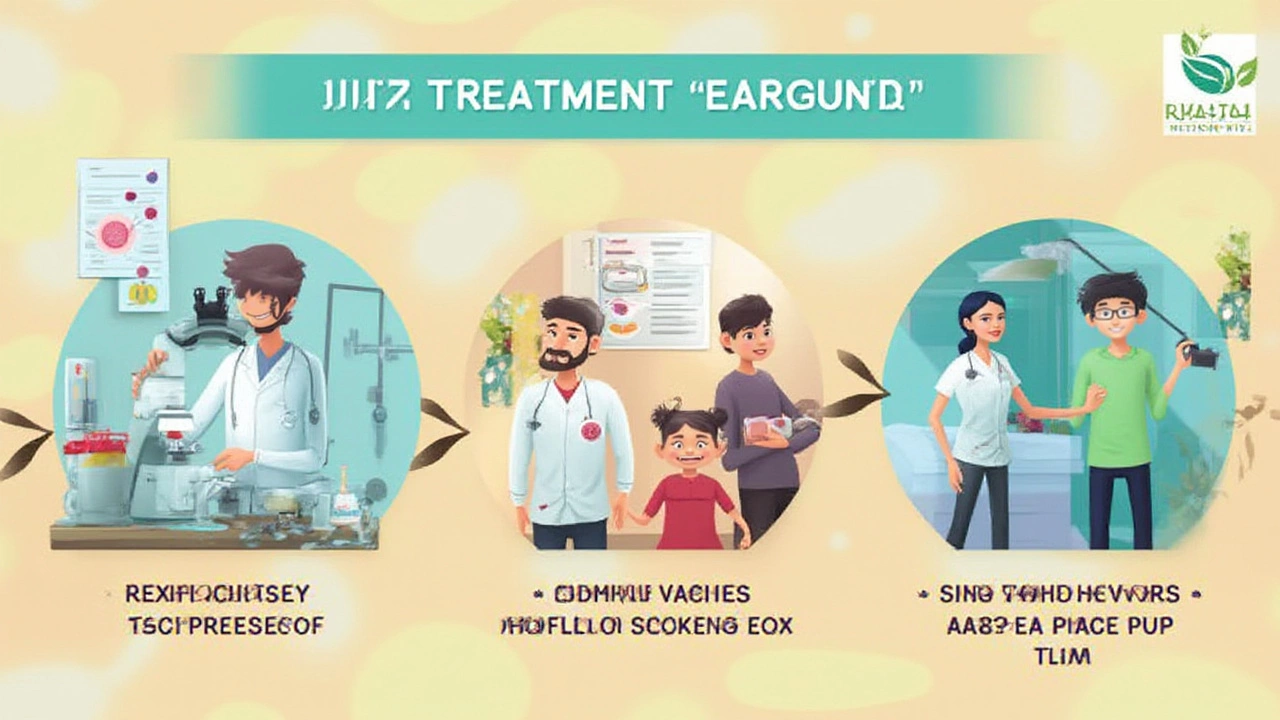It’s wild how science lets us do things our grandparents would have thought impossible, right? Having kids used to mean leaving it all to fate—sometimes crossing every finger and hoping, or dealing with a lot of heartbreak. Fast forward to today, and the idea of getting a helping hand from a lab might sound like something from a futuristic movie, but it’s actually a lifeline for millions. My friend, who’d been trying for years, recently told me the biggest game-changer for her wasn’t even a doctor’s promise—it was seeing those little cells under a microscope, growing into something that could become her baby. Let’s talk straight about IVF, what it really does, how it feels, and some truths most folks don’t share until you’re already standing knee-deep in acronyms and doctor appointments.
What Is IVF and How Does It Work?
First, let’s unpack the basics. IVF stands for In Vitro Fertilization. It’s a medical procedure that helps people have a baby when natural routes aren’t working. But here’s the interesting part—instead of letting nature do everything on its own, IVF brings together eggs and sperm outside the body, in a lab (in vitro actually means “in glass”). Think of it like giving nature a nudge in the right direction, with a lot of science behind it.
I’ve seen couples, friends, even my next-door neighbor’s sister-in-law pour over pamphlets trying to figure out if IVF is right for them. Usually, folks turn to IVF because other options—like medications or simpler fertility treatments—haven’t worked. Some head straight for IVF if there are known issues, like blocked fallopian tubes or very low sperm counts. But it’s also become more common among single parents or same-sex couples, who might need a sperm or egg donor. It’s not a “last resort” anymore. Actually, the CDC reported that in the US, over 330,000 IVF cycles were done in 2023 alone. And worldwide? More than 8 million babies have been born using IVF since it started in 1978. That’s more than the entire population of some countries.
So, what really happens? Here’s what the standard IVF cycle involves, step by step:
- Ovarian stimulation: The person providing the eggs takes hormone medication for about 8-14 days. This makes the ovaries produce more eggs than usual—think of it as encouraging the body to have a bumper crop this month.
- Egg retrieval: When the eggs look ready (doctors track this with ultrasounds), a procedure collects the mature eggs from the ovaries using a fine needle. It’s done with sedation, so most people just feel a bit sore afterward.
- Sperm collection: Either the partner provides a sample, or donor sperm is used. Sperm quality will be checked and prepped for the magic moment.
- Fertilization: Scientists put together the eggs and sperm in a dish, watching closely as the sperm gets busy. Sometimes, a single sperm is injected directly into an egg in a process called ICSI, or Intracytoplasmic Sperm Injection. That’s used when sperm is less likely to fertilize an egg on its own.
- Embryo culture: If fertilization happens, the cells start dividing and growing into embryos. They’re kept for several days in the lab, usually up to 5-6 days, until one or more are strong enough for the next step.
- Embryo transfer: Doctors pick the best embryo(s) and place them gently into the uterus. If the embryo implants, pregnancy begins, just as in any other pregnancy. The rest of the embryos can be frozen (cryopreserved) for future tries.
That’s the journey in a nutshell. Each stage has its own twist and just about everyone’s experience will vary, but this is the backbone of what IVF treatment does: it gives egg and sperm every chance to meet, grow, and start a new life. If you look at the stats, on average, 30-40% of people under 35 succeed per cycle in the US, dropping with age. After age 40, success rates are much lower—around 5-10%—but still, those chances beat zero for so many families.
One thing that gets glossed over a lot is the emotional charge. IVF isn’t just a parade of medical appointments—it can feel like a rollercoaster. The hormones can mess with your mood, there’s the physical discomfort, and sometimes, cycles don’t go as planned. But it’s also pretty awe-inspiring to watch science and hope come together in this way. I’ll never forget my friend’s doctor saying:
“IVF doesn’t just create babies—it gives hope where there wasn’t any. Every cycle is a chance, not just a number.” — Dr. Meera Shah, Fertility Specialist
Curious about what those stats really look like? Here’s a quick table of IVF success rates by age group (2023 data, US):
| Age Group | Live Birth Rate per Cycle |
|---|---|
| Under 35 | 38.1% |
| 35-37 | 31.9% |
| 38-40 | 22.1% |
| 41-42 | 12.3% |
| Over 42 | 4.3% |

Who Can Benefit from IVF—and What to Expect
If you’re thinking IVF is just for couples desperate after years of trying, it’s time to reset that old stereotype. Real talk: it’s for anyone whose path to parenthood needs some extra help. Women over 35 who might have diminished ovarian reserve (basically, fewer healthy eggs left), couples with unexplained infertility (all the tests are fine but still nothing’s happening), folks with genetic diseases they don’t want to pass on, or same-sex couples or single folks who want children. IVF is the tech that opens the door to all of them.
Here’s something most clinics won’t put in the brochure: it’s also about choice. You can screen embryos for certain genetic things, you can freeze eggs while you’re younger (for those thinking ahead), and you can bank extra embryos if you want options for later. For women who have to undergo cancer treatment, freezing eggs or embryos before chemo or radiation lets them try for a baby later. That’s a big deal—being able to put your dreams on ice, literally, and come back when you’re ready and healthy.
But what’s it really like? From watching Vihaan knock over his breakfast because he’s running around with Simba, to Arya climbing furniture in record time, I can’t imagine life without the craziness. That’s what people are fighting for in each IVF round: those noisy, beautiful moments. Yet, it pays to know what might be tough. Most folks find the daily hormone shots daunting at first—nobody loves needles. The mood swings are no joke either (my mate Rohan confessed he nearly burst into tears during a grocery ad). That’s normal—with estrogen jumping up and down, moods follow. And yes, some gain weight or get headaches, though doctors watch carefully to avoid anything too drastic.
Costs are another topic nobody likes to dwell on, but they matter. In the US, one round of IVF averages $12,000 to $15,000, not including meds, genetic testing, or freezing. Those extra bits can bump the bill way up. Insurance? Spotty. Some states or employers cover it, but most don’t pay a dime. Planning ahead financially, or even exploring grants for IVF, is smart.
What helps make everything easier? Tips from families who’ve done it:
- Ask all the questions—no matter how silly they seem. Trust me, doctors have heard every version.
- Plan days off around tough appointments. Recovery isn’t just physical; emotions need space, too.
- Find your circle—friends, family, support groups, or forums can be life-saving on rough days.
- Track your meds and appointments in a planner or app—things move quickly and details matter.
- Don’t forget about your relationship. IVF can take over life—set aside guilt-free time to just be together without talking hormones, needles, or calendars.
For many, the most surprising part is how IVF brings couples (or families) together. Sure, it tests your patience and can totally zap romance out of a date night, but pushing through those ups and downs builds teamwork that lasts way past delivery day. I’ve seen couples come out much stronger, with a new appreciation not just for science but for each other.

IVF: Myths, Advances, and What No One Tells You
It’s easy to fall into scary internet rabbit holes while googling IVF. You’ll find everything from miracle stories to wild rumors. Time to debunk a few myths the old-fashioned way—with real talk and hard facts.
Myth one: IVF always works the first time. That’s just not how it goes. For some, the first round leads to pregnancy, but for many, it takes a few tries. It can be disappointing, and it’s important to be prepared for the possibility of needing more than one cycle.
Myth two: Only women over 40 do IVF. Sure, more women try it as they get older, but younger women or couples with genetic concerns, LGBTQ+ families, and even those with certain medical needs all use IVF. Age affects success rates, but it doesn’t draw the line on who IVF is for.
Myth three: IVF is unsafe or leads to weak babies. Fertility clinics go through strict protocols. The data says that IVF babies are as healthy as those from natural conception, though twins or triplets come with extra risks. These days, doctors usually transfer just one embryo to avoid risky multiples.
Now, about advances—science is moving fast. Embryo genetic screening lets you spot certain chromosomal conditions before pregnancy even starts. Egg freezing is getting popular—giving women more control over their future. And lab culture conditions are better than ever, leading to higher quality embryos. Some clinics use time-lapse video to monitor embryos 24/7, so they can pick the ones most likely to succeed. That wasn’t even possible a decade ago.
What nobody tells you: the wait can be the hardest part. Each stage—from shots, to retrieval, to transfer, to that long two-week wait for a pregnancy test—feels like a lifetime. It helps to find other things to obsess about (I spent hours researching the best toys for Simba, our cat, just to keep my mind busy during a friend’s IVF cycle). Patience, humor, and yes, plenty of snacks, really do help.
People wonder how it feels to actually give birth to an IVF baby. If you ask any parent I know, the answer is simple—it feels just as magically chaotic and beautiful as any other. Nobody asks to see the lab receipts after your baby arrives. It all comes down to the journey that took you there and the stories you’ll someday tell at the dinner table when a certain mischievous child feeds broccoli to the family cat (looking at you, Arya and Simba!).
So next time you hear someone mention IVF, remember: it’s not about test tubes or cold science. It’s about giving hope a shot—quite literally. For millions, it’s the chance to write their own chapter in the wild, messy, incredible story of becoming a parent, no matter how winding the path.



